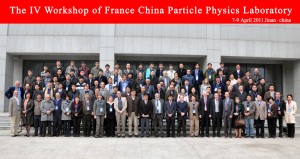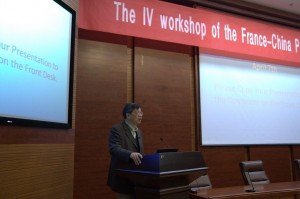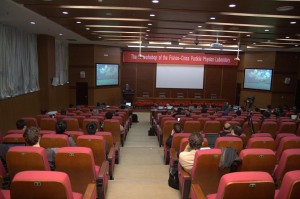
Group photo of the fourth France-China Particle Physics Laboratory held in Shandong University, Jinan, China from 7 to 9 April 2011.
The 4th Workshop of the France-China Particle Physics Laboratory (FCPPL) took place in Shandong University, Jinan, China from 7 to 9 April 2011. The main purpose of these workshops is to present, review and discuss the various ongoing and future activities performed by Chinese and French scientists within the FCPPL framework. More than 100 scientists, engineers and students interested in every aspect of particle physics and advanced accelerators attended the meeting.
An ILC session with six ILC-related talks was held in this 2011 workshop, three for accelerators and three for detectors. In addition to the LHC, the ILC is one of the main fields of collaboration within FCPPL. “It is a fruitful cooperating field,” said Jie Gao, professor at the Institute of High Energy Physics (IHEP), Chinese Academy of Sciences (CAS) and chair of the Asia Linear Collider Steering Committee. The 1.3-gigahertz superconducting technology will become a new item of collaboration within FCPPL since the latest TESLA Technology Collaboration (TTC) meeting hosted by the University of Milan and INFN Sezione di Milano.
FCPPL was established according to an agreement between CAS, the Centre National de la Recherche Scientifique (CNRS) and the French Commission for Atomic Energy (CEA) in April 2007. It is an international associated laboratory supported by funding agencies and the French Embassy in China, and involves a network of French CNRS/IN2P3 laboratories and universities, CEA, a network of institutes of CAS and Chinese universities. It is mainly devoted to strengthening collaborations in particle physics, with a focus on LHC and ILC activities, including computing development and deployment and accelerator studies. The support and development of existing or new collaborations in other particle physics domains and in particle astronomy, both in experimental physics and theory, are also an intrinsic part of this project. Following the creation of FCPPL, the first FCPPL workshop was held in Marseilles, France, from 15 to 17 January 2008.
China and France have a longstanding history of cooperation in particle physics. Between 1987 and 1997, ten accelerator physicists from IHEP went to LAL – an IN2P3 lab in Orsay – for an academic exchange. Then research institutes and universities from China began to cooperate widely with French labs on various projects with, for example and just to name a few: IHEP’s and Shandong University’s cooperation with CPPM – an IN2P3 lab in Marseilles – on the LHC’s ATLAS experiment; Huazhong Normal University and IN2P3 collaborative work on LHC’s ALICE experiment; and Tsinghua University’s and LAL’s cooperation on ILC detector optimisation and particle flow algorithms.
“The joint lab creates a Sino-French research community beyond the individual contacts, and gives a high visibility of cooperation in our countries and in the world,” said Philippe Arnaud from the Science and Technology Department of the French Embassy in China. No doubt, FCPPL has established an official dialogue on a regular basis and promotes new collaboration between France and China. “FCPPL is a laboratory without walls, which enables Chinese and French particle and accelerator scientists to work together towards a new energy frontier with experiments such as the LHC and the ILC,” said Gao. “This joint endeavour is becoming an international culture on which a future linear collider will be based.”



Recent Comments